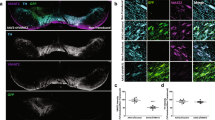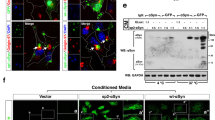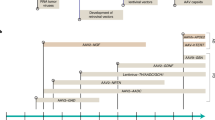Abstract
Adeno-associated viral (AAV) vectors are non-pathogenic, integrating DNA vectors in which all viral genes are removed and helper virus is completely eliminated. To evaluate this system in the post-mitotic cells of the brain, we found that an AAV vector containing the LacZ gene (AAVIac) resulted in expression of β-galactosidase up to three months post-injection in vivo. A second vector expressing human tyrosine hydroxylase (AAVth) was injected into the denervated striatum of unilateral 6-hydroxydopamine-lesioned rats. Tyrosine hydroxylase (TH) immunoreactivity was detectable in striatal neurons and glia for up to four months and we also found significant behavioural recovery in lesioned rats treated with AAVth versus AAVIac controls. Safe and stable TH gene transfer into the denervated striatum may have potential for the genetic therapy of Parkinson's disease.
This is a preview of subscription content, access via your institution
Access options
Subscribe to this journal
Receive 12 print issues and online access
$209.00 per year
only $17.42 per issue
Buy this article
- Purchase on Springer Link
- Instant access to full article PDF
Prices may be subject to local taxes which are calculated during checkout
Similar content being viewed by others
References
Miller, D.G., Adam, M.A & Miller, A.D. Gene transfer by retrovirus vectors occurs only in cells that are actively replicating at the time of infection. Molec. cell. biol. 10, 4329–4242 (1990).
Ho, D.Y. & Mocarski, E.S. B-galactosidase as a marker in the peripheral and neural tissues of the herpes-simplex virus-infected mouse. Virology 167, 279–283 (1988).
Breakefield, X.O. & Deluka, N.A. Herpes simplex virus for gene delivery to neurons. New Biol. 3, 203–218 (1991).
Rotzman, B. & Jenklns, F.J. Genetic engineering of novel genomes of large DNA viruses. Science 229, 1208–1214 (1985).
Johnson, P.A. et al. Cytotoxicrty of a replication defective mutant of herpes simplex virus 1. J. Virol. 66, 2952–2955 (1992).
Le Gal La Salle, G. et al. An adenovirus vector for gene transfer into neruons and glia in the brain. Science 259, 988–990 (1993).
Akli, S. et al. Transfer of a foreign into the brain using adenovirus vectors. Nature Genetics 3, 224–228 (1993).
Davidson, B.L. et al. A model system for in vivo gene transfer into the central nervous system using an adenoviral vector. Nature Genet. 3, 219–223 (1993).
Neve, R.L. Adenovirus vectors enter the brain. Trends Neurosci. 16, 251–253 (1993).
Spaete, R.R. & Frenkel, N. The herpes simplex virus amplicon: A new eucaryotic defective-virus cloning-amplifying vector. Cell. 30, 295–304 (1982).
Kwong, A.D. & Frenkel, N. The herpes simplex virus amplicon IV. Effecient expression of a chimeric chicken ovalbumin gene amplified within defective virus genomes. Virology 142, 421–425 (1985).
Kaplitt, M.G. et al. Expression of afunctional foreign gene in adult mammalian brain following in vivo transfer viaaherpes simplex virus type 1 defective viral vector. Molec. cell. Neurosci. 2, 320–330 (1991).
Kaplitt, M.G. et al. Preproenkephalin promoter yields region-specific and long-term expression in adult brain following direct in vivo gene transfer via a defective herpes simplex viral vector. Proc. natn. Acad. Sci. U.S.A. 19, 8979–8983 (1994).
Ho, D.Y., Mocarski, E.S. & Sapolsky, R.M. Altering central nervous system physiology with a defective herpes simplex virus vector expressing the glucose transporter gene. Proc. natn. Acad. Sci. USA. 90, 3655–3659 (1993).
Geller, A.I., Keyomarski, K., Bryan, J. & Pardee, A.B. An efficient deletion mutant packaging system for defective HSV-1 vectors; potential applications to neuronal physiology and human gene therapy. Proc. natn. Acad. Sci. U.S.A. 87, 8950–8954 (1990).
Bems, K.I. & Hauswirth, W.W. Adeno-associated viruses. Adv. Virus Res. 26, 407–409 (1979).
Muzyczka, N. Use of adeno-associated virus as a general transduction vector for mammalian cells. Curr. Top. Microbiol. Immunol. 158, 97–129 (1992).
Samulski, R.J., Chang, L.-S. & Shenk, T. A recombinant plasmid from which an infectious adeno-associated virus genome can be excised in vitro and its use to study viral replication. J. Virol. 61, 3096–3101 (1987).
Samulski, R.J., Chang, L.-S. & Shenk, T. Helper-free stocks of adeno-associated viruses: normal integration does not require viral gene expression. J. Virol. 63, 3022–3828 (1989).
Yahr, M.D. & Bergmann, K.J. (eds) Parkinson's disease. (Raven Press, New York, 1987).
Yatir, M.D. et al. Treatment of parkinsonism with levadopa. Arch. Neurol. 21, 343–354 (1969).
Wolff, J.A. et al. Grafting fibroblasts genetically modified to produce L-dopa in a rat model of Parkinson's Disease. Proc. natn. Acad. Sci. U.S.A. 86, 9011–9014 (1989).
Freed, W.J. et al. Resoration of dopaminergic function by grafting of fetal rat substantia nigrato the caudate nucleus: long-term behavioral, biochemical, and histochemical studies. Ann. Neurol. 8, 510–519 (1987).
Horrelou, P. et al. In vivo release of dopa and dopamine from genetically engineered cells grafted to the denervated rat striatum. Neuron 5, 393–402 (1990).
Jiao, S., Gurevich, V. & Wolff, J.A. Long term correction of rat model of Parkinson's Disease by gene therapy. Nature 262, 450–453 (1993).
Jones, N.C. & Shenk, T.S. Isolation of deletion and substitution mutants of adenovirus type 5. Cell 13, 181–188 (1978).
Nuovo, G.J. et al. An improved technique for the in situ detection of DMA after polymerase chain reaction amplification. Am. J. Pathol. 139, 1239–1244, (1991).
Nuovo, G.J. et al. Importance of different variables for enhancing in situ detection of PCR-amplified DNA. PCR Meth. Appl. 2, 305–312 (1993).
Flotte, T.R. et al. Stable in vivo expression of the cystic fibrosistransmembrane conductance regulator with an adeno-associated virus vector. Proc. natn. Acad. Sci. U.S.A. 90, 10613–10617 (1993).
O'Malley, K.L. et al. Isolation and characterization of the human tyrosine hydroxylase gene: Identification of 5′ alternative splice sites responsible for multiple mRNAs. Biochemistry 26, 6910–6914 (1987).
Dubach, M. et al. Primate neostriatal neurons containing tyrosine hydroxylase: immunohistochemical evidence. Neurosci. Lett. 75, 205–210 (1990).
Hefti, F., Melamed, E. & Wurtman, R.J. Partial lesions of the dopaminergic nigrostriatal system in rat brain: Biochemical characterization. Brain Res. 195, 123–127 (1980).
Margraves, R. & Freed, W.J. Chronic intrastriatal dopamine infusions in rats with unilateral lesions of the substantia nigra. Life Sci. 40, 959–966 (1987).
Freed, W.J. et al. Resoration of dopaminergic function by grafting of fetal rat substantia nigra to the caudate nucleus: long-term behavioral, biochemical, and histochemical studies. Ann. Neurol. 8, 510–519 (1987).
Lebkowski, J.S., McNally, M.M., Okarma, T.B. & Lerch, L.B. Adeno-associated virus: a vector system for efficient introduction and integration of DNA into a variety of mammalian cell types. Molec. cell. Biol. 8, 3988–3996 (1988).
Scharfmann, R., Axelrod, J.H. & Verma, I.M. Long-term in vivo expression of retrovirus-mediated gene transfer in mouse fibroblast implants. Proc. natn. Acad. Sci. U.S.A. 88, 4626–4630 (1991).
Samulski, R.J. et al. Targeted integration of adeno-associated virus (AAV) into human chromosome 19. EMBO J. 10, 3941–3950 (1991).
McLaughlin, S.K. et al. Adeno-associated virus general transduction vectors: Analysis of proviral structures. J. Virol. 62, 1963–1973 (1988).
Poole, S. et al. Gene transfer into hematopoietic stem cells using AAV vectors: targeted integration into chromosome 19. Blood. (in the press).
Graham, F.L. & van der Eb, A.J. A new technique for the assay of infectivity of human adenovirus 5 DNA. Virology 52, 456–467 (1973).
Graham, F.L., Smiley, J., Russell, W.C. & Nairn, R. Characterization of a human cell line transformed by DNA from human adenovirus type 5. J. gen. Virol. 36, 59–74 (1977).
Paxinos, G. & Watson, C. The rat brain in stereotaxic coordinates. (Academic Press, Australia, 1982).
Perese, D.A., Ulman, J., Viola, J., Ewing, S.E. & Bankiewicz, K.S. A 6-hydroxydopamine-induced selective parkinsonian rat model. Brain Res. 494, 285–293 (1989).
During, M.J. et al. Biochemical and behavioral recovery in a rodent model of Parkinson's Disease following stereotactic implantation of dopamine-containing liposomes. Exp. Neurol. 115, 193–199 (1992).
Author information
Authors and Affiliations
Rights and permissions
About this article
Cite this article
Kaplitt, M., Leone, P., Samulski, R. et al. Long-term gene expression and phenotypic correction using adeno-associated virus vectors in the mammalian brain. Nat Genet 8, 148–154 (1994). https://doi.org/10.1038/ng1094-148
Received:
Accepted:
Issue Date:
DOI: https://doi.org/10.1038/ng1094-148
This article is cited by
-
An efficient rAAV vector for protein expression in cortical parvalbumin expressing interneurons
Scientific Reports (2022)
-
Gene therapy in the CNS—one size does not fit all
Gene Therapy (2021)
-
Viral tools for neuroscience
Nature Reviews Neuroscience (2020)
-
Gene and Cell-Based Therapies for Parkinson’s Disease: Where Are We?
Neurotherapeutics (2020)
-
Adeno-associated virus vector as a platform for gene therapy delivery
Nature Reviews Drug Discovery (2019)



